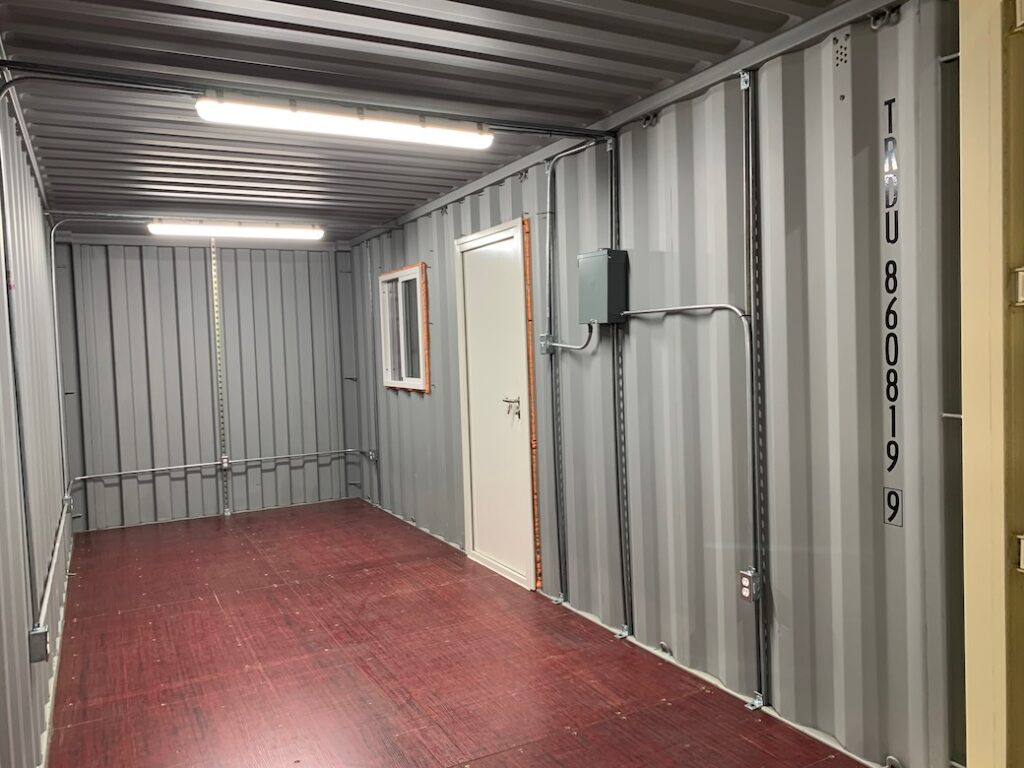Shipping Container Lighting

Shipping container lighting is a crucial aspect of container architecture, as it not only enhances visibility and functionality but also contributes to the aesthetics of the space. Here’s an overview of lighting options commonly used in shipping container conversions:


Natural & Exterior Lighting
Incorporating windows, skylights, or glass doors into the container design

Artificial Lighting
LED strips, recessed lights, track lights, and pendant lights

Task & Ambient Lighting
Wall sconces, or pendant lights with dimming capabilities
Containers With Electricity
Interior LED Lights
LED (Light Emitting Diode) Lighting, Compact Florescent Lamps
Exterior Lights
Outdoor Wall Lights, Floodlights, Solar-Powered Lights
And More
Quick-Connect Plug, Duplex outlets, 100A-Amp Panel

Your Next Steps to Adding Lighting to Your Container
Call
Call or Visit to Discuss Lighting Options
Choose
Choose Your Lighting Type
Enjoy
Enjoy a Container with Lighting

Shipping Container Lighting Reviews




Natural & Exterior Lighting
Maximizing natural light is essential in container architecture to create a bright and inviting interior. This can be achieved by incorporating windows, skylights, or glass doors into the container design. Casement windows, as mentioned earlier, are a popular choice for allowing natural light to penetrate the interior.
Exterior lighting is essential for safety and security, especially for container structures used in outdoor or remote locations. Outdoor wall lights, floodlights, or solar-powered lights can be installed to illuminate pathways, entrances, and surrounding areas.
When planning the lighting for a shipping container conversion, it’s essential to consider factors such as energy efficiency, aesthetics, functionality, and compliance with building codes and regulations. Working with experienced architects, designers, and lighting specialists can help ensure that the lighting design meets your project requirements and enhances the overall appeal and usability of the space.

Artificial Lighting

For spaces where natural light alone is insufficient, artificial lighting solutions are necessary. These can include:
-LED Lighting: LED (Light Emitting Diode) lighting is highly energy-efficient and versatile, making it an excellent choice for container projects. LED strips, recessed lights, track lights, and pendant lights can be used to illuminate different areas of the container.
– Compact Fluorescent Lamps (CFLs): CFLs are another energy-efficient lighting option suitable for container conversions. They come in various shapes and sizes, including screw-in bulbs and tube lights, and can provide a bright, even light output.
Task & Ambient Lighting
Task lighting is focused illumination designed to facilitate specific activities, such as reading, cooking, or working. Task lighting fixtures, such as desk lamps or under-cabinet lights, can be strategically placed to provide targeted illumination where needed.
Ambient lighting creates a general, overall illumination that helps establish the mood and atmosphere of the space. This can be achieved using overhead lights, wall sconces, or pendant lights with dimming capabilities to adjust the brightness as desired.

Ready to explore all container modifications? Get Simple Box offers a wide range of container modifications to suit your needs and you budget.

We’ll treat you like we’d want to be treated.
- No pushy sales techniques
- No out-of-state contractors
- No cussing or crudeness
- Helpful service offered with a smile
We focus on being local, professional, and kind. If at any point you have questions or concerns, a local manager is standing by and ready to help within 1 business day.
Get Container Modification Prices
We're looking forward to helping you get a Modified Shipping container. Fill out the form and we'll reply quickly with a no-pressure estimate.
"*" indicates required fields
Frequently Asked Questions
LED lighting is often recommended for shipping container conversions due to its energy efficiency, versatility, and durability. Other options include compact fluorescent lamps (CFLs) and task lighting fixtures.
You can maximize natural light by incorporating windows, skylights, or glass doors into the container design. Consider using casement windows, clerestory windows, or large glass panels for optimal daylighting.
LED strip lights, recessed ceiling lights, track lights, and pendant lights are popular choices for illuminating container interiors. These fixtures provide even illumination and can be customized to suit different design preferences.
Yes, LED lighting is highly energy-efficient and can help reduce electricity consumption in shipping container conversions. LED fixtures consume less power, have a longer lifespan, and produce less heat compared to traditional lighting sources.
Yes, many LED lighting fixtures are available with dimming capabilities, allowing you to adjust the brightness levels according to your preferences. Dimmable lighting can create ambiance and save energy by reducing light output when full brightness is not required.
Exterior lighting is essential for safety and security. Consider installing outdoor wall lights, floodlights, or solar-powered lights to illuminate pathways, entrances, and surrounding areas. Ensure that exterior lighting fixtures are weatherproof and suitable for outdoor use.
Yes, solar-powered lights are a practical option for off-grid or remote container projects where access to electricity may be limited. Solar-powered lighting fixtures harness energy from the sun and can provide illumination without relying on grid power.
It’s essential to consult local building codes and regulations to ensure compliance with lighting requirements for container conversions. Work with experienced architects, designers, and electricians who are familiar with container construction and applicable building codes.
Yes, you can customize the lighting design to suit your specific needs and preferences. Work with professionals to create a lighting plan that enhances the functionality, aesthetics, and ambiance of your container space.
LED lighting fixtures require minimal maintenance due to their long lifespan and durability. Regular cleaning and occasional bulb replacement may be necessary to ensure optimal performance. Follow manufacturer guidelines for maintenance and care of lighting fixtures.